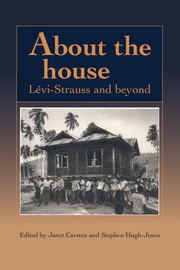Book contents
- Frontmatter
- Contents
- List of illustrations
- List of contributors
- 1 Introduction
- 2 Houses and hierarchies in island Southeast Asia
- 3 The resurrection of the house amongst the Zafimaniry of Madagascar
- 4 The hearth-group, the conjugal couple and the symbolism of the rice meal among the Kelabit of Sarawak
- 5 Houses in Langkawi: stable structures or mobile homes?
- 6 Having your house and eating it: houses and siblings in Ara, South Sulawesi
- 7 The Lio House: building, category, idea, value
- 8 Houses and hierarchy: the view from a South Moluccan society
- 9 Houses, places and people: community and continuity in Guiana
- 10 The houses of the Mẽbengokre (Kayapó) of Central Brazil – a new door to their social organization
- 11 Inside-out and back-to-front: the androgynous house in Northwest Amazonia
- Notes
- Bibliography
- Index
4 - The hearth-group, the conjugal couple and the symbolism of the rice meal among the Kelabit of Sarawak
Published online by Cambridge University Press: 05 June 2012
- Frontmatter
- Contents
- List of illustrations
- List of contributors
- 1 Introduction
- 2 Houses and hierarchies in island Southeast Asia
- 3 The resurrection of the house amongst the Zafimaniry of Madagascar
- 4 The hearth-group, the conjugal couple and the symbolism of the rice meal among the Kelabit of Sarawak
- 5 Houses in Langkawi: stable structures or mobile homes?
- 6 Having your house and eating it: houses and siblings in Ara, South Sulawesi
- 7 The Lio House: building, category, idea, value
- 8 Houses and hierarchy: the view from a South Moluccan society
- 9 Houses, places and people: community and continuity in Guiana
- 10 The houses of the Mẽbengokre (Kayapó) of Central Brazil – a new door to their social organization
- 11 Inside-out and back-to-front: the androgynous house in Northwest Amazonia
- Notes
- Bibliography
- Index
Summary
Lévi-Strauss (1983a, 1983b, 1987) looks at two aspects of what he terms ‘house-based societies’. In the chapter on ‘The social organization of the Kwakiutl’ in The Way of the Masks (1983a) he takes a historical approach to his subject and looks in particular at European noble houses. Here he places a good deal of emphasis on the way in which the ‘house’ perpetuates itself from generation to generation and discusses the house as ‘a corporate body holding an estate … which perpetuates itself … down a real or imaginary line …’ (1983a: 174).
In his later lectures on ‘The concept of house’ and ‘On Indonesia’, published in Anthropology and Myth in 1987, Lévi-Strauss is more interested in the way that the ‘house’ enables antagonistic principles to be resolved. He appears to be arguing that there is one core antagonism, resolved in the house, to which all others may be reduced. This is between descent and alliance. The conjugal couple, which he describes as ‘the true kernel of the family, and more generally, of the kindred’ (1987: 155) appears to symbolize, for Lévi-Strauss, the focal importance of alliance. He seems to be arguing that the achievement of alliance is what the house is about. Through the conjugal couple, and the house which symbolizes their union, this is made possible.
- Type
- Chapter
- Information
- About the HouseLévi-Strauss and Beyond, pp. 84 - 104Publisher: Cambridge University PressPrint publication year: 1995
- 20
- Cited by



